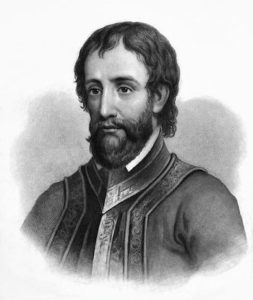
Hernando de Soto
*The birth of Hernando de Soto is affirmed on this date in 1496. He was a Spanish explorer, slave trader, and conquistador involved in the middle passage.
His expeditions in Nicaragua and the Yucatan Peninsula included the conquest of the Inca Empire in Peru. He led the first European expedition deep into the territory of the modern-day United States, the first European documented as having crossed the Mississippi River. Hernando de Soto was born in Extremadura, Spain, to parents who were both hidalgos, nobility of modest means.
Hernando de Soto was born in the current province of Badajoz. A few years before his birth, the Kingdoms of Castille and Aragon conquered the last Islamic kingdom of the Iberian Peninsula. Spain and Portugal were filled with young men seeking a chance for military fame after the defeat of the Moors. With Christopher Columbus's discovery of new lands across the ocean to the west, young men were attracted to rumors of adventure, glory, and wealth.
He sailed to the Americas and was appointed as the first Governor of Panama. In 1520 he participated in the conquest of Nicaragua under Francisco Hernández de Córdoba in 1524. There he acquired a public office in León, Nicaragua. His leadership, unwavering loyalty, and ruthless schemes for extorting Indigenous villages for their captured chiefs became de Soto's hallmarks during the conquest of Central America. He gained fame as an excellent horseman, fighter, and tactician.
In 1530, de Soto led an expedition up the coast searching for a passage between the Atlantic Ocean and the Pacific Ocean to enable trade with the Orient, the richest market in the world. Failing that, he left his estates in Nicaragua. Bringing his men on ships that he hired, de Soto joined Francisco Pizarro at his first base shortly before departure for the interior of present-day Peru. Pizarro quickly made de Soto one of his captains.
By 1534, de Soto was serving as lieutenant governor of Cuzco while Pizarro was building his new capital on the coast; it later became known as Lima. In 1535 King Charles awarded Diego de Almagro the governorship of the southern portion of the Inca Empire. When de Almagro made plans to explore and conquer the southern part of the Inca empire (now Chile), de Soto applied to be his second-in-command but was turned down. De Soto packed up his treasure and returned to Spain. De Soto returned to Spain in 1536, with wealth gathered from plunder in the Spanish conquest of the Inca Empire. He was admitted into the prestigious Order of Santiago and "granted the right to conquer Florida." He married Isabel de Bobadilla, daughter of a relative of a confidante of Queen Isabella.
He was granted the governorship of Cuba. De Soto selected 620 Spanish and Portuguese mixed-race African Atlantic Creole volunteers to accompany him to govern Cuba and colonize North America. Averaging 24 years of age, the men embarked from Havana on seven of the King's ships and two caravels of de Soto's. With tons of heavy armor and equipment, they also carried more than 500 head of livestock, including 237 horses and 200 pigs, for their planned four-year continental expedition. De Soto was expected to colonize the North American continent for Spain within four years, for which his family would be given a sizable piece of land.
He encountered and decimated the native Taino communities and others during this voyage. In May 1539, de Soto landed in an area generally identified as south Tampa Bay. Historian Robert S. Weddle has suggested that he landed at either Charlotte Harbor or San Carlos Bay. He named the land Espíritu Santo after the Holy Spirit. Near de Soto's port, the party found Juan Ortiz, a Spaniard living with the Mocoso people. Since his capture, Ortiz developed a method for guiding the expedition and communicating with the various tribes, who spoke many dialects and languages.
He recruited guides from each tribe along the route. A chain of communication was established whereby a guide who had lived near another tribal area could pass his information and language on to a guide from a neighboring area. De Soto remained loyal to Ortiz, allowing him the freedom to dress and live among the natives. Another important guide was the seventeen-year-old boy Perico, or Pedro, from now Georgia. He spoke several of the local tribes' languages and could communicate with Ortiz. Perico was taken as a guide in 1540.
The Spanish used slave and indigenous labor. Perico was treated better due to his value to the Spaniards. The expedition traveled north, exploring Florida's West Coast and encountering native ambushes and conflicts. De Soto's first winter encampment was at Anhaica, the capital of the Apalachee people, a future stronghold Fort would emerge for escaped African slaves. It is one of the few places on the route where archaeologists have found physical traces of the expedition. The chroniclers described this settlement near the "Bay of Horses." The bay was named for events of the 1527 Narváez expedition, the members of which, dying of starvation, killed and ate their horses while building boats for escape by the Gulf of Mexico. Hernando De Soto died of a fever on May 21, 1542, near present-day McArthur, Arkansas, or in Louisiana) on the western bank of the Mississippi. Louisiana erected a historical marker at the estimated site.